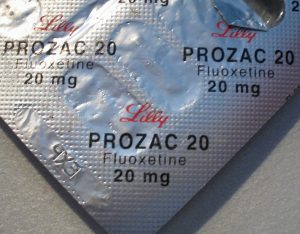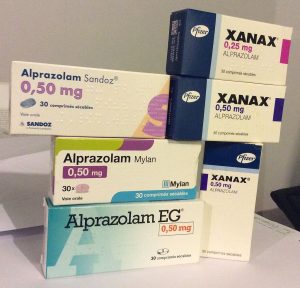10.3 Antidepressant and Anti-Anxiety Medications
Many of the medications that will be discussed here can be used to treat a few different pathologies. For example, antidepressants may also be given to patients with anxiety. This may possibly be because the patient suffers from both pathologies or because it is effective for long-term treatment for either pathology. Treatment of depression, and most other pathologies that have been discussed, may include medication, but also ideally a mix of psychotherapy, cognitive behavioural therapy (CBT), possibly electroconvulsive therapy (ECT), and maybe even group therapy.
Antidepressant Medications
Antidepressants, also known as mood-elevating medications, are used to treat depression and other mental health disorders, as well as other medical conditions such as migraine headaches, chronic pain, and premenstrual syndrome. Antidepressants increase levels of neurotransmitters in the central nervous system, including serotonin, dopamine, and norepinephrine.
Four classes of antidepressants will be discussed, including tricyclic antidepressants (TCAs), selective serotonin reuptake inhibitors (SSRIs), serotonin norepinephrine reuptake inhibitors (SNRIs), and monoamine oxidase inhibitors (MAOIs). TCAs and MAOIs are referred to as first-generation antidepressants because they were first marketed in the 1950s. SSRIs and SNRIs are called second-generation antidepressants and are popular because they have fewer side effects.
Black Box Warnings are in place for all classes of antidepressants used with children, adolescents, and young adults because of a higher risk of suicide. All patients receiving antidepressants should be monitored for signs of worsening depression or changes in behaviour, especially when the medication is started or dosages are changed.
Monoamine Oxidase Inhibitors (MAOI)
Monoamine oxidase inhibitors (MAOIs) are a first-generation antidepressant. A significant disadvantage to MAOIs is their potential to cause a hypertensive crisis when taken with stimulant medications or foods containing tyramine.
Tranylcypromine (Parnate) is an example of an MAOI. The mechanism of action of tranylcypromine is not fully understood but is presumed to be linked to the potentiation of monoamine neurotransmitter activity in the central nervous system resulting from its irreversible inhibition of the enzyme monoamine oxidase (MAO). MAO inactivates norepinephrine, dopamine, epinephrine, and serotonin. Tranylcypromine is indicated for the treatment of major depressive disorder in adult patients who have not responded to other antidepressants. It may also be used to treat Parkinson’s disease.
MAOs must be used with caution due to the risks of a hypertensive crisis, serotonin syndrome, and increased suicidality. A hypertensive crisis is defined by severe hypertension (blood pressure greater than 180/120 mmHg) with evidence of organ dysfunction. Symptoms may include a headache (which may radiate frontally), chest palpitations, neck stiffness or soreness, nausea and/or vomiting, sweating, dilated pupils, photophobia, shortness of breath, and/or confusion. Either tachycardia or bradycardia may be present and may be associated with chest pain.
Other potential side effects include mania, orthostatic hypotension, seizures, hypoglycemia in diabetic patients, decreased appetite and weight loss, dizziness, headache, drowsiness, and restlessness.
- bupropion (Aplenzin, Wellbutrin)
- nefazodone (Oleptro)
- trazodone (Brintellix)
Tricyclic Antidepressants
Tricyclic antidepressants (TCAs) were one of the original first-generation antidepressants and were named for the triple-ring configuration in their chemical structure. Owing to the popularity of SSRIs and SNRIs, TCAs are now more commonly used to treat neuropathic pain and insomnia.
Amitriptyline (Elavil) is an antidepressant that also has sedative effects. Its mechanism of action is not known. Amitriptyline inhibits the membrane pump mechanism responsible for the uptake of norepinephrine and serotonin in neurons. This interference with the reuptake of norepinephrine or serotonin is believed to cause the antidepressant activity of amitriptyline.
Potential side effects of TCA include the following:
- Tachycardia
- Urinary retention
- Constipation
- Dry mouth
- Blurred vision
- Exacerbation of narrow-angle glaucoma
- Cognitive impairment
- Psychomotor slowing
- Confusion
- Sedation
- Delirium
If the physician decides to stop the medication after prolonged use, it is important to gradually decrease the dosage to avoid symptoms such as nausea, headache, and malaise.
Examples of tricyclic antidepressants:
- amoxapine (Asendin)
- desipramine (Norpramin)
- doxepin (Sinequan)
- imipramine (Tofranil)
- nortriptyline (Aventyl, Pamelor)
Key Concept
Selective Serotonin Reuptake Inhibitors (SSRIs)
Selective serotonin reuptake inhibitors (SSRIs) are second-generation antidepressants and have fewer side effects than TCAs and MAOIs. SSRIs inhibit the reuptake of serotonin. They are primarily used to treat depression, but are also used to treat obsessive compulsive disorder, bulimia, panic disorder, post-traumatic stress disorder, some forms of anxiety, premenstrual syndrome, and migraines.
The development of potentially life-threatening serotonin syndrome or neuroleptic malignant syndrome (NMS)–like reactions have been reported with SNRIs and SSRIs. Symptoms of serotonin syndrome may include mental status changes (e.g., agitation, hallucinations, and coma), autonomic instability (e.g., tachycardia and hyperthermia), and gastrointestinal symptoms (nausea, vomiting, and diarrhea). Serotonin syndrome, in its most severe form, can resemble neuroleptic malignant syndrome (NMS), which includes hyperthermia, muscle rigidity, possible rapid fluctuation of vital signs, and mental status changes.

- citalopram (Celexa)
- escitalopram (Lexapro)
- fluoxetine (Prozac) (Fig. 10.2)
- fluvoxamine (Luxor)
- proxetine (Paxil)
- sertraline (Zoloft)
Key Concept
Serotonin Norepinephrine Reuptake Inhibitors (SNRIs)
Serotonin norepinephrine reuptake inhibitors (SNRIs) are indicated for the treatment of major depressive disorders. SNRIs work by inhibiting the reuptake of serotonin and norepinephrine, with weak inhibition of dopamine reuptake.

- desvenlafaxine (Pristiq)
- duloxetine (Cymbalta)
- levomilnacipran (Fetzima)
- venlafaxine (Effexor) (Fig. 10.3)
The video below provides an overview of antidepressants and how they can be treated with antidepressants:
(Miller, 2015)
Anti-Anxiety Medications
Anxiety treatment can include non-pharmacological interventions as well as medications. Non-pharmacological interventions to decrease anxiety include relaxation techniques such as deep breathing, exercise, psychotherapy, support groups, or cognitive behavioural therapy (CBT). Anti-anxiety medications, also referred to as anxiolytics, can also be used to help patients feel more at ease and can be used as needed (PRN). Many anti-anxiety medications are classified as minor tranquilizers and include benzodiazepines.
Benzodiazepines
Benzodiazepines are given for acute, or sometimes ongoing, anxiety. They are a controlled Schedule IV substance because they have the potential for abuse and may lead to dependence. As discussed in previous chapters, benzodiazepines can also be used for their sedative and anticonvulsant effects.

Examples of benzodiazepines:
- alprazolam (Xanax) (Fig. 10.4)
- chlordiazepoxide (Librium)
- diazepam (Valium)
- lorazepam (Ativan)
Key Concept
Antidepressants for Anxiety
Patients experiencing anxiety may also be prescribed the antidepressant medications discussed above. It is not uncommon for patients to be on tricyclic antidepressants (TCAs), selective serotonin reuptake inhibitors (SSRIs), or serotonin and norepinephrine reuptake inhibitors (SNRIs).
Table 10.1. Common Psychiatric Medications
| Generic Name | Trade Name | Reason for Administering |
| tranylcypromine | Parnate | Depression, Parkinson’s disease |
| bupropion | Aplenzin, Wellbutrin | Depression |
| nefazodone | Oleptro | Depression |
| trazodone | Brintellix | Depression |
| amitriptyline | Elavil | Depression, insomnia, neuropathic pain |
| amoxapine | Asendin | Depression, insomnia, neuropathic pain |
| desipramine | Norpramin | Depression, insomnia, neuropathic pain |
| doxepin | Sinequan | Depression, insomnia, neuropathic pain |
| imipramine | Tofranil | Depression, insomnia, neuropathic pain |
| nortriptyline | Aventyl, Pamelor | Depression, insomnia, neuropathic pain |
| citalopram | Celexa | Depression |
| escitalopram | Lexapro | Depression |
| fluoxetine | Prozac | Depression |
| fluvoxamine | Luxor | Depression |
| paroxetine | Paxil | Depression |
| sertraline | Zoloft | Depression |
| desvenlafaxine | Pristiq | Depression |
| duloxetine | Cymbalta | Depression |
| levomilnacipran | Fetzima | Depression |
| venlafaxine | Effexor | Depression |
| diazepam | Valium | Anxiety |
| chlordiazepoxide | Librium | Anxiety |
| alprazolam | Xanax | Anxiety |
| lorazepam | Ativan | Anxiety |
(WebMD, 2022)
Attribution
Unless otherwise indicated, material on this page has been adapted from the following resource:
Ernstmeyer, K., & Christman, E. (Eds.). (2020). Nursing pharmacology. Chippewa Valley Technical College. https://wtcs.pressbooks.pub/pharmacology/, licensed under CC BY 4.0
References
Miller, B. (2015, August 28). Treating depression with antidepressants [Video]. YouTube. https://www.youtube.com/watch?v=pGEQILM7C7Y&t=2s&ab_channel=BrookeMiller
WebMD. (2023). Drugs and medications A–Z. https://www.webmd.com/drugs/2/index
Prozac by Maksim, CC BY-SA 3.0
Venlafaksiiniin perustuvia lääkkeitä by Anniina Järvelä, Public domain
Boites de Xanax et d’alprazolam en ce moment dans les pharmacies by Gotgot44, CC BY-SA 4.0
also known as "talk therapy"; a way to help people with a broad variety of mental illnesses and various emotional difficulties
a form of structured, time-limited, problem-focused, and goal-oriented therapy
a procedure, done under general anesthesia, in which small electric currents are passed through the brain to intentionally trigger a brief seizure
chemical messengers in the body
the strictest labeling requirements the FDA can mandate for prescription medications, often because of potential adverse effects that can occur when a medication is taken
having high blood pressure
an amino acid that helps regulate blood pressure; found in dried fruit such as raisins, apricots, and prunes, as well as in oranges, grapefruit, lemons, limes, and pineapples
the action of restricting or hindering a process
eye discomfort in bright light; sensitivity to light
increased heart rate
slow heart rate
extreme emotional highs; often associated with bipolar disorder
a decrease in blood pressure when moving from a sitting to a standing position
low blood sugar
disease caused by damage or injury to the nerves
hearing, seeing, smelling, tasting, or feeling touched by things that are not there
a medication with a low potential for abuse

